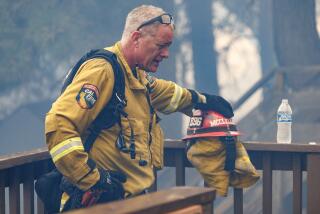Fighting Fire With Fliers : Drought: The Air National Guard is adding pilots in anticipation of an extremely dangerous season.
Fearing an especially dangerous fire season, officials are beefing up the ranks of firefighting pilots stationed at the Channel Islands Air National Guard base.
“We’re anticipating a bad season,” said Lt. Col. Ron Boll of the 146th Tactical Airlift Wing unit. “We’ve upped our numbers, adding additional pilots.”
The 146th unit has pilots and flight personnel ready to back up state, local and federal agencies by making air drops of fire retardant from C-130 transport planes.
The C-130s used on the missions are equipped with 45-foot-long aluminum storage units carrying the fire retardant. There are eight such storage units, called Modular Airborne Firefighting Systems, in the country, Boll said.
The Channel Islands station has two and the others are located around the United States at other Air National Guard stations and an Air Force Reserve unit, Boll said.
U.S. Forest Service officials said they expect to rely on the military services to fight fires this summer and fall.
“They really help us do the job that we have to do,” said Lonnie Briggs, assistant fire management officer for the Los Padres National Forest. “If we end up with a catastrophic year like we did last year, we’d have a major problem if we couldn’t call those aircraft.”
The fire season, which officially began last month in Southern California, is expected to be extremely dangerous because of brush dried during five years of drought and plants killed in the December freeze, authorities said.
In addition, March rains made the grounds moist enough to support tall grasses, which already are drying out and could serve as wicks to ignite areas of denser foliage.
The U.S. Forest Service contracts with private businesses to provide air tankers to dump retardant on fires. They are obligated to call those firms first, Briggs said.
However, there are only 11 private tankers available to the U.S. Forest Service in California, Briggs said. They are quickly engaged during a large fire or multiple fires.
“We get to a point fairly quickly where we don’t have enough aircraft,” Briggs said.
The California Department of Forestry also can appeal to the governor’s office for military help when it runs out of air carriers, Boll said.
Pilots on fire missions from the 146th unit have been deployed primarily throughout California, but also have made forays to Washington, Oregon and Yellowstone National Park.
In 1983, the unit spent 1 1/2 months fighting fires throughout Italy when that country’s government requested help from the United States, Boll said. Last summer, firefighting pilots used the Guard station near Point Mugu as home base to make air drops on the fires that raged in Santa Barbara County.
Flying as close to the fires as possible, pilots can zero in on a house on fire or a ridge of flames and douse it with up to 3,000 gallons of pink-tinged retardant. At maximum pressure, the sticky retardant, which is biodegradable, can be dispensed in six to seven seconds, Boll said.
The unit plans to demonstrate the firefighting abilities of the plane and retardant-storage system during the 29th annual Point Mugu Air Show in July.
Twenty pilots in the 146th unit have been trained for the prestigious firefighting missions. The operations can pose some dangers.
“You’re operating at high temperature, high weight and mountainous terrain,” Boll said. “It’s a very demanding aerial mission. You wouldn’t go flying in conditions like that for fun.”
More to Read
Sign up for Essential California
The most important California stories and recommendations in your inbox every morning.
You may occasionally receive promotional content from the Los Angeles Times.










